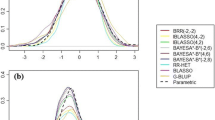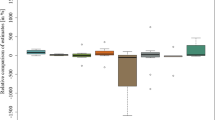Abstract
Using the data of crosses of multiple of inbred lines for mapping QTL can increase QTL detecting power compared with only cross of two inbred lines. Although many fixed-effect model methods have been proposed to analyze such data, they are largely based on one-QTL model or main effect model, and the interaction effects between QTL are always neglected. However, effectively separating the interaction effects from the residual error can increase the statistical power. In this article, we both extended the novel Bayesian model selection method and Bayesian shrinkage estimation approaches to multiple inbred line crosses. With two extensions, interacting QTL are effectively detected with high solution; in addition, the posterior variances for both main effects and interaction effects are also subjected to full Bayesian estimate, which is more optimal than two step approach involved in maximum-likelihood. A series of simulation experiments have been conducted to demonstrate the performance of the methods. The computer program written in FORTRAN language is freely available on request.





Similar content being viewed by others
References
Christianse MJ, Feenstra B, Skovgaard IM, Andersen SB (2006) Genetic analysis of resistance to yellow rust in hexaploid wheat using a mixture model for multiple crosses. Theor Appl Genet 112:581–591
Hastings WK (1970) Monte Carlo sampling methods using Markov chains and their applications. Biometrika 57:97–109
Kao CH, Zeng Z-B, Teasdale RD (1999) Multiple interval mapping for quantitative trait loci. Genetics 152:1203–1216
Li RH, Lyons MA, Wittenburg H, Paigen B, Churchill GA (2005) Combining data from multiple inbred line crosses improves the power and resolution of quantitative trait loci mapping. Genetics 169:1699–1709
Liu Y, Zeng Z-B (2000) A general mixture model approach for mapping quantitative trait loci from diverse cross designs involving multiple inbred lines. Genet Res 75:345–355
Liu Y, Jansen GB, Lin CY (2004) Quantitative trait loci mapping for dairy cattle production traits using a maximum likelihood method. J Dairy Sci 87:491–500
Metropolis RN, Rosenbluth AW, Teller MN, Teller AH (1953) Equations of state calculations by fast computing machines. J Chem Phys 21:1087–1091
Muranty H (1996) Power of tests for quantitative trait loci detection using full-sib families in different schemes. Heredity 76:156–165
Rebai A, Goffinet B (1993) Power of tests for QTL detection using replicated progenies derived from a diallel cross. Theor Appl Genet 86:1014–1022
Satagopan JM, Yandell BS, Newton MA, Osborn TC (1996) A Bayesian approach to detect quantitative trait loci using Markov chain Monte Carlo. Genetics 144:805–816
Sillanpää MJ, Arjas E (1998) Bayesian mapping of multiple quantitative trait loci from incomplete inbred line cross data. Genetics 148:1373–1388
Sillanpää MJ, Corander J (2002) Model choice in gene mapping: what and why. Trends Genet 18:301–307
Uimari P, Hoeschele I (1997) Mapping linked quantitative trait loci using Bayesian method analysis and Markov chain Monte Carlo algorithms. Genetics 146:735–743
Wang H, Zhang YM, Li X, Masinde GL, Mohan S, Baylink DJ, Xu S (2005) Bayesian shrinkage estimation of quantitative trait loci parameters. Genetics 170:465–480
Xu S (1998) Mapping quantitative trait loci using multiple families of line crosses. Genetics 148:517–524
Yi N (2004) A unified Markov chain Monte Carlo framework for mapping multiple quantitative trait loci. Genetics 167:967–975
Yi N, Xu S (2001) Bayesian mapping of quantitative trait loci under complicated mating designs. Genetics 157:1759–1771
Yi N, Xu S (2002) Linkage analysis of quantitative trait loci in multiple line crosses. Genetica 114:217–230
Yi N, Allison DB, Xu S (2003) Bayesian model choice and search strategies for mapping multiple epistatic quantitative trait loci. Genetics 165:867–883
Yi N, Xu S, George V, Allison DB (2004) Mapping multiple quantitative trait loci for ordinal traits. Behav Genet 34:3–15
Yi N, Yandell BS, Churchill GA, Allison DB, Eisen EJ, Pomp D (2005) Bayesian mode selection for genome-wide epistatic quantitative trait loci analysis. Genetics 170:1333–1344
Zhang YM, Xu S (2005) Advanced statistical methods for detecting multiple quantitative trait loci. Recent Res Devel Genet Breeding 2:1–23
Acknowledgments
We thank two anonymous reviewers for their criticisms and comments which have greatly improved the presentation of the manuscript. The research was supported by Heilongjiang August First Land Reclamation University.
Author information
Authors and Affiliations
Corresponding author
Appendix: conditional posterior distributions
Appendix: conditional posterior distributions
Conditional posterior distribution of model effects
The conditional posterior distributions of all model effects are normal. For popular mean u, the conditional posterior distribution of it follows
If the number of individuals in each cross is different, n will be substituted by n j , and the rules holds in all steps. For cross specific effect, the conditional posterior distribution of it is
for j = 1,...,m. The conditional posterior distribution for main effect b jq is
q = 1,...,K and j = 1,...,m, and for interaction effect w j,q_1 q_2 is
for q 1 = 1,...,K, q 2 < q 1 and j = 1,...,m.
Conditional posterior distribution of residual error σ 2 e
For the residual variance σ 2 e , the conditional posterior distribution is a scaled inverse chi-square, \(\sigma _e^2 \sim \chi ^{-2}(mn,SS_e ),\) where,
Conditional posterior distribution of QTL genotypes
The conditional posterior distribution of QTL genotypes is
where, z = −1 or 1, indicates two different genotypes of QTL.
Rights and permissions
About this article
Cite this article
Fang, M., Jiang, D., Chen, X. et al. Bayesian analysis of genetic architecture of quantitative trait using data of crosses of multiple inbred lines. Genetica 134, 367–375 (2008). https://doi.org/10.1007/s10709-008-9244-z
Received:
Accepted:
Published:
Issue Date:
DOI: https://doi.org/10.1007/s10709-008-9244-z




